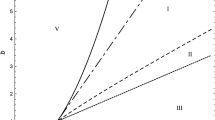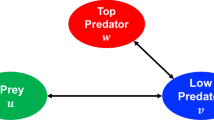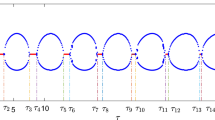Abstract
The existence and implications of alternative stable states in ecological systems have been investigated extensively within deterministic models. However, it is known that natural systems are undeniably subject to random fluctuations, arising from either environmental variability or internal effects. Thus, in this paper, we study the role of noise on the pattern formation of a spatial predator–prey model with Allee effect. The obtained results show that the spatially extended system exhibits rich dynamic behavior. More specifically, the stationary pattern can be induced to be a stable target wave when the noise intensity is small. As the noise intensity is increased, patchy invasion emerges. These results indicate that the dynamic behavior of predator–prey models may be partly due to stochastic factors instead of deterministic factors, which may also help us to understand the effects arising from the undeniable susceptibility to random fluctuations of real ecosystems.



Similar content being viewed by others
References
Turing, A.M.: The chemical basis of morphogenesis. Philos. Trans. R. Soc. Lond. B 237, 37–72 (1952)
Haken, H.: Synergetics. An Introduction, Springer Series in Synergetics, vol. 1. Springer, Berlin (1977)
Nicolis, G., Prigogine, I.: Self-Organization in Nonequilibrium Systems. Wiley, New York (1977)
Weidlich, W., Haag, G.: Concepts and Models of a Quantitative Sociology. The Dynamics of Interacting Populations, Springer Series in Synergetics. Springer, Berlin (1983)
Medvinsky, A.B., Petrovskii, S.V., Tikhonova, I.A., Malchow, H., Li, B.-L.: Spatiotemporal complexity of plankton and fish dynamics. SIAM Rev. 44(3), 311–370 (2002)
Baurmann, M., Gross, T., Feudel, U.: Instabilities in spatially extended predator-prey systems: spatio-temporal patterns in the neighborhood of Turing-Hopf bifurcations. J. Theor. Biol. 245, 220–229 (2007)
Sun, G.Q., Jin, Z., Liu, Q.X., Li, L.: Pattern formation induced by cross-diffusion in a predator–prey system. Chin. Phys. B 17, 3936–3941 (2008)
Sun, G.Q., Jin, Z., Liu, Q.X., Li, L.: Dynamical complexity of a spatial predator–prey model with migration. Ecol. Model. 219, 248–255 (2008)
Murray, J.D.: Mathematical Biology. Springer, Berlin (1989)
Holling, C.S.: Resilience and stability of ecological systems. Ann. Rev. Ecolog. Syst. 4, 1–23 (1973)
Folke, C., Carpenter, S.R., Walker, B., Scheffer, M., Elmqvist, T., Gunderson, L.H., Holling, C.: Regime shifts, resilience, and biodiversity in ecosystem management. Annu. Rev. Ecol. Evol. Syst. 35, 557–581 (2004)
Scheffer, M., Rinaldi, S., Kuznetsov, Y.A., van Nes, E.H.: Seasonal dynamics of Daphnia and algae explained as a periodically forced predator-prey system. Oikos 80, 519–532 (1997)
Scheffer, M., Rinaldi, S.: Minimal models of top-down control of phytoplankton. Freshw. Biol. 45, 265–283 (2000)
Guttal, V., Jayaprakash, C.: Impact of noise on bistable ecological systems. Ecol. Model. 201, 420–428 (2007)
Vilar, J.G., Solé, R.V.: Effects of noise in symmetric two-species competition. Phys. Rev. Lett. 80(18), 4099–4102 (1998)
Mankin, R., Laas, T., Sauga, A., Ainsaar, A.: Colored-noise-induced Hopf bifurcations in predator-prey communities. Phys. Rev. E 74, 021101 (2006)
Mankin, R., Laas, T., Soika, E., Ainsaar, A.: Noise-controlled slow–fast oscillations in predator–prey models with the Beddington functional response. Eur. Phys. J. B 59, 1434–6036 (2007)
Rai, R., Singh, H.: Stochastic resonance without an external periodic drive in a simple prey–predator model. Phys. Rev. E 62, 8804–8807 (2000)
Lai, Y.-C.: Beneficial role of noise in promoting species diversity through stochastic resonance. Phys. Rev. E 72, 042901 (2005)
Barbera, A.L., Spagnolo, B.: Spatio-temporal patterns in population dynamics. Phys. A 314, 120–124 (2002)
Spagnolo, B., Cirone, M., Barbera, A.L., de Pasquale, F.: Noise-induced effects in population dynamics. J. Phys. Condens. Matter 14, 2247–2255 (2002)
Vilar, J.M.G., Solé, R.V., Rubí, J.M.: On the origin of plankton patchiness. Phys. A 317, 239–246 (2003)
Kortlüke, O., Kuzovkov, V.N., von Niessen, W.: Internal spatiotemporal stochastic resonance in the presence of weak noise. Phys. Rev. E 66, 036139 (2002)
Sun, G.Q., Zhang, G., Jin, Z., Li, L.: Predator cannibalism can give rise to regular spatial pattern in a predator–prey system. Nonlinear Dyn. (2009, in press)
Sun, G.Q., Jin, Z., Zhao, Y.G., Liu Q.X., Li, L.: Spatial pattern in a predator-prey system with both self- and cross-diffusion. Int. J. Mod. Phys. C (2009, in press)
Allee, W.C.: The Social Life of Animals. Norton, New York (1938)
Dennis, B.: Allee effects: population growth, critical density, and the chance of extinction. Nat. Res. Model. 3, 481–538 (1989)
Amarasekare, P.: Interactions between local dynamics and dispersal: insights from single species models. Theor. Popul. Biol. 53, 44–59 (1998)
Gyllenberg, M., Hemminki, J., Tammaru, T.: Allee effects can both conserve and create spatial heterogeneity in population densities. Theor. Popul. Biol. 56, 231–242 (1999)
Petrovskii, S.V., Vinogradov, M.E., Morozov, A.Y.: Spatio-temporal horizontal plankton patterns caused by biological invasion in a two-species model of plankton dynamics allowing for the Allee effect. Oceanology 42, 384–393 (2002)
Nisbet, R.M., Gurney, W.S.C.: Modelling Fluctuating Populations. Wiley, Chichester (1982)
Holmes, E.E., Lewis, M.A., Banks, J.E., Veit, R.R.: Partial differential equations in ecology: spatial interactions and population dynamics. Ecology 75, 17–29 (1994)
Sherratt, J.A.: Periodic travelling waves in cyclic predator-prey systems. Ecol. Lett. 4, 30–37 (2001)
Segel, L.A., Jackson, J.L.: Dissipative structure: an explanation and an ecological example. J. Theor. Biol. 37, 545–559 (1972)
Morozov, A., Petrovskii, S., Li, B.-L.: Bifurcations and chaos in a predator–prey system with the Allee effect. Proc. R. Soc. Lond. B 271, 1407–1414 (2004)
Lewis, M.A., Kareiva, P.: Allee dynamics and the spread of invading organisms. Theor. Popul. Biol. 43, 141–158 (1993)
Petrovskii, S.V., Morozov, A.Y., Venturino, E.: Allee effect makes possible patchy invasion in a predator–prey system. Ecol. Lett. 5, 345–352 (2002)
Sun, G., Jin, Z., Liu, Q.-X., Li, L.: Pattern formation in a spatial s-i model with non-linear incidence rates. J. Stat. Mech. 11, P11011 (2007)
Reichenbach, T, Mobilia, M, Frey, E.: Noise and correlations in a spatial population model with cyclic competition. Phys. Rev. Lett. 99, 238105 (2007)
Reichenbach, T., Mobilia, M., Frey, E.: Mobility promotes and jeopardizes biodiversity in rock–paper–scissors games. Nature 448, 1046 (2007)
Liu, Q., Li, B., Jin, Z.: Resonance and frequency-locking phenomena in a spatially extended phytoplankton–zooplankton system with additive noise and periodic forces. J. Stat. Mech. P05011 (2008)
Blasius, B., Huppert, A., Stone, L.: Complex dynamics and phase synchronization in spatially extended ecological systems. Nature 399, 354 (1999)
Mankin, R., et al.: Trichotomous-noise-induced catastrophic shifts in symbiotic ecosystems. Phys. Rev. E 65, 051108 (2002)
Mankin, R., et al.: Colored-noise-induced discontinuous transitions in symbiotic ecosystems. Phys. Rev. E 69, 061106 (2004)
Higham, D.J.: An algorithmic introduction to numerical simulation of stochastic differential equations. SIAM Rev. 43 525 (2001)
Pascual, M.: Diffusion-induced chaos in a spatial predator- prey system. Proc. R. Soc. B 251, 1–7 (1993)
Sherratt, J.A., Lewis, M.A., Fowler, A.C.: Ecological chaos in the wake of invasion. Proc. Natl. Acad. Sci. U. S. A. 92, 2524–2528 (1995)
Petrovskii, S., Li, B-L., Malchow, H.: Transition to spatiotemporal chaos can resolve the paradox of enrichment. Ecol. Complex. 1, 37 (2004)
Wilson, W.G.: Resolving discrepancies between deterministic population models and individual-based simulations. Am. Nat. 151, 116 (1998)
Morozov, A., Petrovskii, S., Li, B.L.: Spatiotemporal complexity of patchy invasion in a predator–prey system with the Allee effect. J. Theor. Biol. 238, 18–35 (2006)
Petrovskii, S.V., Morozov, A.Y., Li, B.-L.: Regimes of biological invasion in a predator–prey system with the Allee effect. Bull. Math. Biol. 67, 637–661 (2005)
Sherratt, J.A., Lambin, X., Sherratt, T.N.: The effects of the size and shape of landscape features on the formation of traveling waves in cyclic populations. Am. Nat. 162, 503–513 (2003)
Ovaskainen, O., Sato, K., Bascompte, J., Hanski, I.: Metapopulation models for extinction threshold in spatially correlated landscapes. J. Theor. Biol. 215, 95–108 (2002)
Bascompte, J., Rodríguez, M.A.: Self-disturbance as a source of spatiotemporal heterogeneity: the case of the Tallgrass Prairie. J. Theor. Biol. 204, 153–164 (2000)
Bascompte, J., Solé R.V.: Effects of habitat destruction in a prey–predator metapopulation model. J. Theor. Biol. 195, 383–393 (1998)
Neufeld, Z., et al.: Excitable media in open and closed chaotic flows. Phys. Rev. E 66, 066208 (2002)
Zhou, C., et al.: Noise-sustained coherent oscillation of excitable media in a chaotic flow. Phys. Rev. Lett. 91, 150601 (2003)
Hernandez-Garcia, E., Lopez, C.: Sustained plankton blooms under open chaotic flows. Ecol. Complex 1, 253 (2004)
Neufeld, Z., et al.: Ocean fertilization experiments may initiate a large scale phytoplankton bloom. Geophys. Res. Lett. 29, 1534 (2002)
Hernandez-Garcia, E., Lopez, C., Neufeld, Z.: Small-scale structure of nonlinearly interacting species advected by chaotic flows. Chaos 12, 470 (2002)
Tzella, A., Haynes, P.H.: Small-scale spatial structure in plankton distributions. Biogeosciences 4, 173 (2007)
Reigada, R., et al.: Plankton blooms induced by turbulent flows. Proc. R. Soc. B 270, 875 (2003)
Acknowledgements
This work is supported by the National Natural Science Foundation of China under Grant No. 60771026, Program for New Century Excellent Talents in University (NCET050271), the Natural Science Foundation of Shan’Xi Province Grant No. 2006011009, the Special Scientific Research Foundation for the Subjects of Doctors in University (20060110005), and Graduate Students’ Excellent Innovative Item of Shanxi Province No. 20081018.
Author information
Authors and Affiliations
Corresponding author
Appendix: More detail about noise term η(r, t)
Appendix: More detail about noise term η(r, t)
The Ornstein–Uhlenbeck process obeys the following stochastic partial differential equation:
where ξ(r,t) is a Gaussian white noise with zero mean and correlation,
As a result, the colored noise η(r,t), which is temporally correlated and white in space, satisfies
where τ controls the temporal correlation, and ε measures the noise intensity.
Rights and permissions
About this article
Cite this article
Sun, GQ., Jin, Z., Li, L. et al. The role of noise in a predator–prey model with Allee effect. J Biol Phys 35, 185–196 (2009). https://doi.org/10.1007/s10867-009-9139-y
Received:
Accepted:
Published:
Issue Date:
DOI: https://doi.org/10.1007/s10867-009-9139-y




